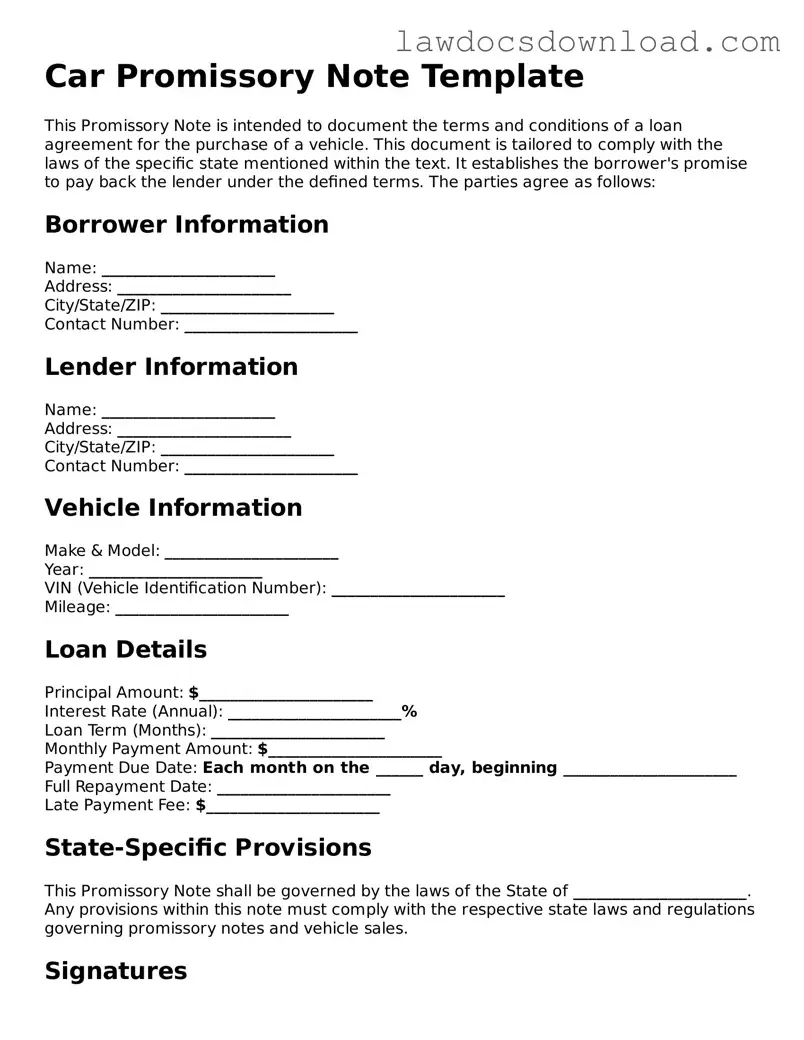A Loan Agreement is closely related to a Promissory Note for a Car, as both outline the terms under which money is lent to purchase something, but a Loan Agreement typically provides more comprehensive details. It specifies the obligations of each party, interest rates, repayment terms, and the consequences of default. This document is often more formal and can include clauses concerning the resolution of disputes and jurisdiction, making it broader in scope than a simple promissory note.
A Mortgage Agreement shares similarities with a Promissory Note for a Car because both are forms of secured loans. In a Mortgage Agreement, the property is used as security for the loan, much like how a vehicle secures the loan in a Promissory Note for a Car. Both documents outline borrower’s repayment obligations and specify what happens if the borrower fails to make payments. However, a Mortgage Agreement typically involves real estate, whereas a Promissory Note for a Car is specific to vehicles.
A Personal Loan Agreement is similar because it also documents a loan between two parties, but it's more general and can apply to various types of loans beyond just vehicle purchases. Like a Promissory Note for a Car, it outlines the loan amount, repayment schedule, interest rate, and the consequences of not repaying the loan. The key difference is in their specificity; the Personal Loan Agreement isn't limited to car purchases and can cover a wide range of personal borrowing situations.
The Bill of Sale complements a Promissory Note for a Car by providing documented proof of the transfer of ownership from the seller to the buyer, often required in addition to proving the financial aspects of the transaction. While a Promissory Note outlines the terms under which the car is financed, a Bill of Sale confirms the transaction itself, detailing the item sold, sale date, and parties to the transaction. It serves as a receipt for the buyer and the seller.
A Vehicle Lease Agreement is akin to a Promissory Note for a Car, with the primary difference being that it pertains to renting a vehicle over a fixed period, not purchasing it. Both documents define terms such as the monthly payment amount and maintenance obligations, but a Lease Agreement also details terms regarding the return of the vehicle, mileage limits, and lease termination conditions.
An IOU (I Owe You) is a simple acknowledgment of debt much like a Promissory Note for a Car, which states that one party owes another a certain sum of money. However, IOUs are less formal and typically do not include detailed repayment terms, interest rates, or security interests in property. They serve as basic evidence of a debt's existence rather than a comprehensive lending agreement.
An Installment Agreement bears resemblance to a Promissory Note for a Car as it arranges for the repayment of a loan through regular payments over time. However, Installment Agreements can apply to any type of debt, not just car loans, and specify the installment amounts, due dates, interest rates, and the consequences of late or missed payments. It's a versatile document used for various debts beyond just vehicle financing.
A Guarantee Agreement is related in that it involves a third party agreeing to fulfill the obligations of a debtor in case of default, similar to how collateral might secure a Promissory Note for a Car. While a Promissory Note indicates the borrower’s promise to pay back the loan, a Guarantee Agreement provides an additional level of security for the lender, ensuring that the loan will be repaid either by the borrower or the guarantor.
A Security Agreement complements a Promissory Note for a Car by providing a legal framework that allows the lender to take possession of the collateral (the car) in the event of default. It outlines the process for repossession and sale of the collateral to recover the owed amount. Like a Promissory Note, it is a vital document in secured loans, detailing the rights concerning the secured asset, ensuring the lender has a means of recouping their loan if payments are not made.
